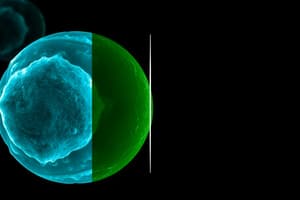Podcast
Questions and Answers
What is the name given to the process where a cell is programmed to slow down and eventually stop dividing?
What is the name given to the process where a cell is programmed to slow down and eventually stop dividing?
- Apoptosis (correct)
- Meiosis
- Mitosis
- Cytokinesis
Which phase of mitosis involves the separation of sister chromatids?
Which phase of mitosis involves the separation of sister chromatids?
- Prophase
- Metaphase
- Telophase
- Anaphase (correct)
What is the primary function of mitosis in multicellular organisms?
What is the primary function of mitosis in multicellular organisms?
- Production of gametes for sexual reproduction
- Repair and maintenance of tissues (correct)
- Genetic recombination for diversity
- Reduction of chromosome number in daughter cells
Which of the following is NOT a characteristic of apoptosis?
Which of the following is NOT a characteristic of apoptosis?
What is the significance of the nuclear envelope disappearing during prophase of mitosis?
What is the significance of the nuclear envelope disappearing during prophase of mitosis?
What is the primary difference between the daughter cells produced during mitosis and those produced during meiosis?
What is the primary difference between the daughter cells produced during mitosis and those produced during meiosis?
Which of the following is a key characteristic of cancer cells?
Which of the following is a key characteristic of cancer cells?
What happens to the chromosomes during anaphase of mitosis?
What happens to the chromosomes during anaphase of mitosis?
Darwin's observations of the Galapagos finches supported the idea that species:
Darwin's observations of the Galapagos finches supported the idea that species:
Darwin’s observation of the Megatherium skull on the Argentinian coast near Buenos Aires supported the idea that:
Darwin’s observation of the Megatherium skull on the Argentinian coast near Buenos Aires supported the idea that:
Darwin's reading of Lyell's Principles of Geology during his voyage on the HMS Beagle influenced his thinking by:
Darwin's reading of Lyell's Principles of Geology during his voyage on the HMS Beagle influenced his thinking by:
Darwin's observation of marine fossils found high above sea level indicated that:
Darwin's observation of marine fossils found high above sea level indicated that:
The idea that organisms are well-suited to their environment can be best described by which of the following terms?
The idea that organisms are well-suited to their environment can be best described by which of the following terms?
Darwin's observations on the HMS Beagle led him to propose which of these ideas?
Darwin's observations on the HMS Beagle led him to propose which of these ideas?
Which of the following was NOT a significant aspect of Darwin's voyage on the HMS Beagle?
Which of the following was NOT a significant aspect of Darwin's voyage on the HMS Beagle?
Why was Darwin's observation of the Megatherium skull significant?
Why was Darwin's observation of the Megatherium skull significant?
What does a higher similarity in DNA sequences between two species indicate?
What does a higher similarity in DNA sequences between two species indicate?
What is the main focus of cladistics in classifying organisms?
What is the main focus of cladistics in classifying organisms?
Which statement best describes shared derived characters?
Which statement best describes shared derived characters?
Which of the following is an example of a shared character?
Which of the following is an example of a shared character?
Why are reptiles, birds, and mammals grouped together as amniotes?
Why are reptiles, birds, and mammals grouped together as amniotes?
What does the presence of homologous structures in organisms indicate?
What does the presence of homologous structures in organisms indicate?
Which of the following is NOT a method used to differentiate organisms?
Which of the following is NOT a method used to differentiate organisms?
What can biochemical similarities between organisms indicate?
What can biochemical similarities between organisms indicate?
Why do scientists group organisms into categories representing lines of evolutionary descent?
Why do scientists group organisms into categories representing lines of evolutionary descent?
What does the term 'theory' imply in a scientific context?
What does the term 'theory' imply in a scientific context?
Which statement about embryological similarities is correct?
Which statement about embryological similarities is correct?
What is the main idea behind the theory of evolution?
What is the main idea behind the theory of evolution?
What misconception did people hold about the earth prior to the 1800s?
What misconception did people hold about the earth prior to the 1800s?
What role does a 'molecular clock' play in understanding evolutionary relationships?
What role does a 'molecular clock' play in understanding evolutionary relationships?
What does genetic similarity indicate about two organisms?
What does genetic similarity indicate about two organisms?
Who initially proposed that acquired traits could be inherited?
Who initially proposed that acquired traits could be inherited?
What observation can be made about fossils in relation to current organisms?
What observation can be made about fossils in relation to current organisms?
What evidence supported the theory of uniformitarianism?
What evidence supported the theory of uniformitarianism?
Which two figures contributed significantly to the study of fossils in comparing past species to current ones?
Which two figures contributed significantly to the study of fossils in comparing past species to current ones?
What does evolutionary theory attempt to explain?
What does evolutionary theory attempt to explain?
Which of the following concepts conflicts with modern evolutionary theory?
Which of the following concepts conflicts with modern evolutionary theory?
Which kingdom is characterized by prokaryotic organisms without peptidoglycan cell walls?
Which kingdom is characterized by prokaryotic organisms without peptidoglycan cell walls?
In terms of cell organization, which kingdoms primarily contain unicellular organisms?
In terms of cell organization, which kingdoms primarily contain unicellular organisms?
Which of the following is NOT a characteristic that keeps organisms apart?
Which of the following is NOT a characteristic that keeps organisms apart?
Which type of nutrition describes organisms that acquire food from other organisms?
Which type of nutrition describes organisms that acquire food from other organisms?
What are the primary components of the cell structure in Eubacteria?
What are the primary components of the cell structure in Eubacteria?
Which of these kingdoms is primarily multicellular and capable of photosynthesis?
Which of these kingdoms is primarily multicellular and capable of photosynthesis?
What is the classification of organisms that are unicellular and lack a nucleus?
What is the classification of organisms that are unicellular and lack a nucleus?
Which of the following correctly describes organs' capabilities related to respiration?
Which of the following correctly describes organs' capabilities related to respiration?
Which of the following examples represents a heterotrophic organism?
Which of the following examples represents a heterotrophic organism?
What are must-have processes for all living organisms according to the classification?
What are must-have processes for all living organisms according to the classification?
Flashcards
Cladistics
Cladistics
The study of evolutionary relationships between organisms based on shared derived characteristics.
Shared Characters
Shared Characters
Features that are shared by all members of a group, inherited from a common ancestor.
Derived Characters
Derived Characters
Features that evolved uniquely within a specific group, not inherited from a common ancestor.
DNA Similarity and Evolutionary Divergence
DNA Similarity and Evolutionary Divergence
Signup and view all the flashcards
Amino Acid Sequence Differences and Evolutionary Divergence
Amino Acid Sequence Differences and Evolutionary Divergence
Signup and view all the flashcards
Homologous structures
Homologous structures
Signup and view all the flashcards
Analogous structures
Analogous structures
Signup and view all the flashcards
Vestigial structures
Vestigial structures
Signup and view all the flashcards
Homology and evolutionary relationships
Homology and evolutionary relationships
Signup and view all the flashcards
Biochemical similarities
Biochemical similarities
Signup and view all the flashcards
Genetic similarities
Genetic similarities
Signup and view all the flashcards
Embryological similarities
Embryological similarities
Signup and view all the flashcards
Phylogeny
Phylogeny
Signup and view all the flashcards
Autotroph
Autotroph
Signup and view all the flashcards
Heterotroph
Heterotroph
Signup and view all the flashcards
Prokaryotic
Prokaryotic
Signup and view all the flashcards
Eukaryotic
Eukaryotic
Signup and view all the flashcards
Kingdoms
Kingdoms
Signup and view all the flashcards
Domains
Domains
Signup and view all the flashcards
Nutrition
Nutrition
Signup and view all the flashcards
Respiration
Respiration
Signup and view all the flashcards
Excretion
Excretion
Signup and view all the flashcards
Reproduction
Reproduction
Signup and view all the flashcards
Apoptosis
Apoptosis
Signup and view all the flashcards
Cancer Cell Division
Cancer Cell Division
Signup and view all the flashcards
Mitosis
Mitosis
Signup and view all the flashcards
Prophase (Mitosis)
Prophase (Mitosis)
Signup and view all the flashcards
Metaphase (Mitosis)
Metaphase (Mitosis)
Signup and view all the flashcards
Anaphase (Mitosis)
Anaphase (Mitosis)
Signup and view all the flashcards
Telophase (Mitosis)
Telophase (Mitosis)
Signup and view all the flashcards
Cytokinesis
Cytokinesis
Signup and view all the flashcards
Scientific Theory
Scientific Theory
Signup and view all the flashcards
Evolution
Evolution
Signup and view all the flashcards
Uniformitarianism
Uniformitarianism
Signup and view all the flashcards
Paleontology
Paleontology
Signup and view all the flashcards
Special Creation
Special Creation
Signup and view all the flashcards
Lamarckism
Lamarckism
Signup and view all the flashcards
Transmutation of Species
Transmutation of Species
Signup and view all the flashcards
Evolutionary Change
Evolutionary Change
Signup and view all the flashcards
Adaptation to Local Environments
Adaptation to Local Environments
Signup and view all the flashcards
Darwin's Finches
Darwin's Finches
Signup and view all the flashcards
Evidence of Evolution from Fossils
Evidence of Evolution from Fossils
Signup and view all the flashcards
Gradualism in Geology
Gradualism in Geology
Signup and view all the flashcards
Collecting Flora and Fauna
Collecting Flora and Fauna
Signup and view all the flashcards
Organisms Well-Suited to Their Environments
Organisms Well-Suited to Their Environments
Signup and view all the flashcards
Darwin's Notebooks
Darwin's Notebooks
Signup and view all the flashcards
Voyage of the HMS Beagle
Voyage of the HMS Beagle
Signup and view all the flashcards
Study Notes
Biology Exam Review
- Ian Hobdari is the instructor
- Topics covered by the review include: Diversity of Living Things, Genetics, Evolution, and Animal Systems
- Lessons 1-4, 1-8, 1-6, and 1-4 respectively, for Diversity of Living Things, Genetics, Evolution, and Animal Systems, are included in the review.
Studying That Suits You
Use AI to generate personalized quizzes and flashcards to suit your learning preferences.




